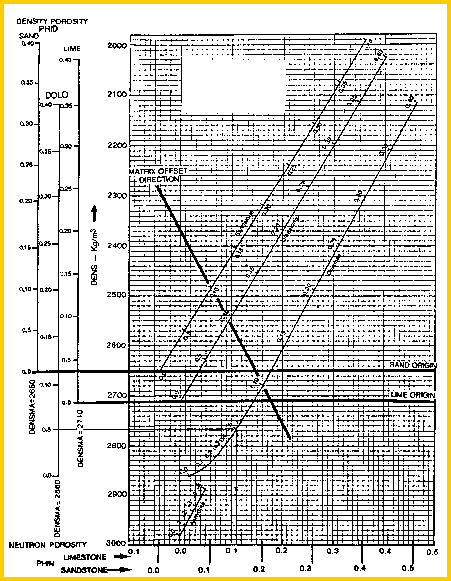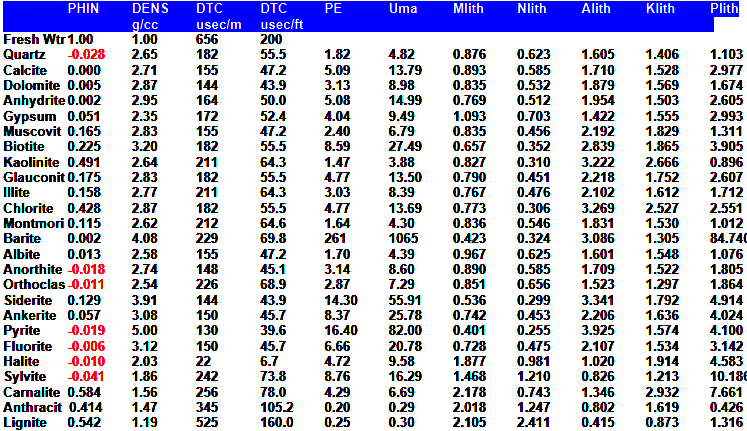|
 Lithology from Matrix
Density
Lithology from Matrix
Density
The response equation for the density log follows the classical
form:
1:
DENS = PHIe * Sxo * DENSw (water term)
+ PHIe * (1 - Sxo) * DENSh (hydrocarbon term)
+ Vsh * DENSsh (shale term)
+ (1 - Vsh - PHIe) * Sum (Vi * DENSi) (matrix term)
Where:
DENSh = log reading in 100% hydrocarbon
DENSi = log reading in 100% of the ith component of matrix rock
DENS = log reading
DENSHsh = log reading in 100% shale
DENSw = log reading in 100% water
PHIe = effective porosity (fractional)
Sxo = water saturation in invaded zone (fractional)
Vi = volume of ith component of matrix rock
Vsh = volume of shale (fractional)
By
rearranging the density response equation, we can derive apparent
matrix density, based on the final effective porosity, shale volume,
and the density log reading. Sxo is assumed to be 1.0. The matrix
density thus derived can be compared to the known matrix density
data
to find an approximate lithology.
Calculate
density log value from porosity log reading.
2: DENS = PHID * KD1 + (1 - PHID)
* KD2
3: DENSSH = PHIDSH * KD1 + (1 - PHIDSH)
* KD2
Calculate matrix density
4: IF Vsh + PHIe < 0.95
5: THEN DENSma = (DENS - PHIe * DENSW - Vsh * DENSSH) / (1 - PHIe
- Vsh)
6: OTHERWISE DENSma = DENS
Calculate mineral volumes (relative to each other)
7: Vmin1 = (DENSma - DENS2) / (DENS1 - DENS2)
8: Vmin2 = 1 - Vmin1
Calculate mineral volumes (relative to total rock volume)
9: Vrock = (1.0 - Vsh - PHIe)
10: V1 = Vmin1 * Vrock
11: V2 = Vmin2 * Vrock
Where:
DENS = density log reading (gm/cc or kg/m3)
DENS1 = density of first mineral (gm/cc or kg/m3)
DENS2 = density of second mineral (gm/cc or kg/m3)
DENSma = calculated matrix density (gm/cc or kg/m3)
DENSSH = density log reading in shale (gm/cc or kg/m3)
DENSW = density log reading in water (gm/cc or kg/m3)
PHID = porosity log reading (fractional)
PHIe = effective porosity from any method (fractional)
PHIDSH = porosity log reading in shale (fractional)
Vsh = volume of shale (fractional)
Vrock = rock volume (fractional)
Vmin1 = volume of first mineral (fractional)
Vmin2 = volume of second mineral (fractional)
Volumes for lithology track:
V1 = relative volume of first mineral (fractional)
V2 = relative volume of second mineral (fractional)
 Constants
Constants
English Units Metric Units Log Scale
KD1 1.00 1000 All
KD2 2.65 2650 Sandstone
KD2
2.71 2710 Limestone
KD2
2.87 2870 Dolomite
 COMMENTS:
COMMENTS:
This equation will break down when PHIe plus Vsh approaches 1.0,
so we limit the use of the equation to those cases where PHIe
+ Vsh < 0.95.
The
matrix density will be too low in gas zones and in rough hole.
No obvious correction can be made to overcome this problem. Do
not use apparent matrix densities under these conditions.
The
standard density neutron crossplot can be used to determine matrix
density, as shown below.

Density neutron crossplot to find DENSma
 NUMERICAL
EXAMPLE:
NUMERICAL
EXAMPLE:
1. For Sand D in Example 1:
PHID = 0.12
PHIe = 0.11
Vsh = 0.33
DENSW = 1000 kg/m3
DENSMA = 2150 kg/m3
DENS = 0.12 * 1.00+ (1 - 0.12) * 2.65 = 2.452
DENSSH = 0.03 * 1.00 + (1 - 0.03) * 2.65 = 2.600
DENSW = 1.000
DENSma = (2.452 - 0.11 * 1.0 - 0.33 * 2.65) / (1 - 0.11
- 0.33) = 2.620 g/cc
2.
If we use the Vsh from the density neutron crossplot (Vsh = 0.59)
DENSma = (2.452 - 0.11 * 1.0 - 0.59 * 2.65) / (1 - 0.11
- 0.59) = 4.680 g/cc
This
is an impossible result which suggests that the shale volume or
the effective porosity is wrong. Calculated matrix density can
thus be used as a quality control indicator when it exceeds reasonable
bounds.
3.
Assume the two mineral model consists of quartz and dolomite and
the computed matrix density is 2680 kg/m3. Then:
Vsh = 0.10
PHIe = 0.20
DENS1 = 2650 kg/m3 (Sandstone)
DENS2 = 2870 kg/m3 (Dolomite)
Vrock = 1 - 0.10 - 0.20 = 0.70
Vmin1 = (2680 - 2870) / (2650 - 2870) = 0.86
Vmin2 = 1.00 - 0.86 = 0.14
Volumes for lithology track:
V1 = 0.86 * 0.70 = 0.60
V2 = 0.14 * 0.70 = 0.10
PHIe + Vsh + Vmin1 + Vmin2 = 0.20 + 0.10 + 0.60
+ 0.10 = 1.00
This rock is composed of 10% shale, 20% porosity, 60% quartz, 10%
dolomite. The quartz/dolomite ratio is 0.86 to 0.14.= 6.14.
 DENSITY
LITHOLOGY CODES
DENSITY
LITHOLOGY CODES
To
produce a lithology code on computer listings, we bracket the
DENSma values as follows:
DlithCode - Density Lithology Codes
DENSma DlithCode
< 2630 and bad hole HOLE
< 2630 and coal trigger set COAL
< 2630 and good hole GAS
2630 - 2659 QRTZ
** 2660 - 2699 LMSD
** 2700 - 2729 LIME
** 2730 - 2799 LMDL
2800 - 2879 DOLO
2880 - 3149 ANHY
3150 and above HEVY
no value computed ----
any value and Vsh > 0.85 SHLE
** Could be DLSD if PE < 3.0
Evaporites
require special handling in computer programs and the above codes
should be expanded to include:
DENSma DLITHCODE
2500 - 2629 gas or bad hole as above
2300 - 2499 GYPS
2000 - 2299 and low sonic SALT
2000 - 2299 and high sonic SULF
1800 - 1999 SYLV
1500 - 1799 CARN
 PARAMETERS
PARAMETERS


|

